Particle Number Measurements Directly from the Tailpipe for Type Approval of Heavy-Duty Engines
Abstract
:Featured Application
Abstract
1. Introduction
2. Materials and Methods
3. Results
3.1. Length of Heated Line
3.2. Crankcase Emissions
3.3. Regenerations
3.4. Sub-23 nm Fractions
3.5. Emission Levels
3.6. Tailpipe Comparisons
4. Discussion
5. Conclusions
Author Contributions
Funding
Acknowledgments
Conflicts of Interest
Disclaimer
Abbreviations
| APC | AVL particle counter |
| c | Cold |
| CNG | Compressed natural gas |
| CoV | Coefficient of variance |
| CPC | Condensation particle counter |
| CS | Catalytic stripper |
| CVS | Constant volume sampling |
| DOC | Diesel oxidation catalyst |
| DPF | Diesel particulate filter |
| ET | Evaporation tube |
| EU | European Union |
| FAME | Fatty acid methyl esters |
| FTP | Federal Test Procedure |
| h | Hot |
| JRC | Joint Research Centre |
| nR | Non-regenerating |
| NRTC | Non-road transient cycle |
| OEM | Original equipment manufacturers |
| PCRF | Particle number concentration reduction factor |
| PD | Proportional partial flow dilution |
| PEMS | Portable emissions measurement systems |
| PM | Particulate matter |
| PMP | Particle measurement programme |
| PND | Particle number diluter |
| R | Regenerating |
| RDE | Real-driving emissions |
| SCR | Selective Catalytic Reduction for NOx |
| SPCS | Solid particle counting system |
| SPN | Solid particle number |
| TP | Tailpipe |
| TWC | Three-way Catalytic Converter |
| WHSC | World harmonised stationary cycle |
| WHTC | World harmonised transient cycle |
Appendix A

Appendix B

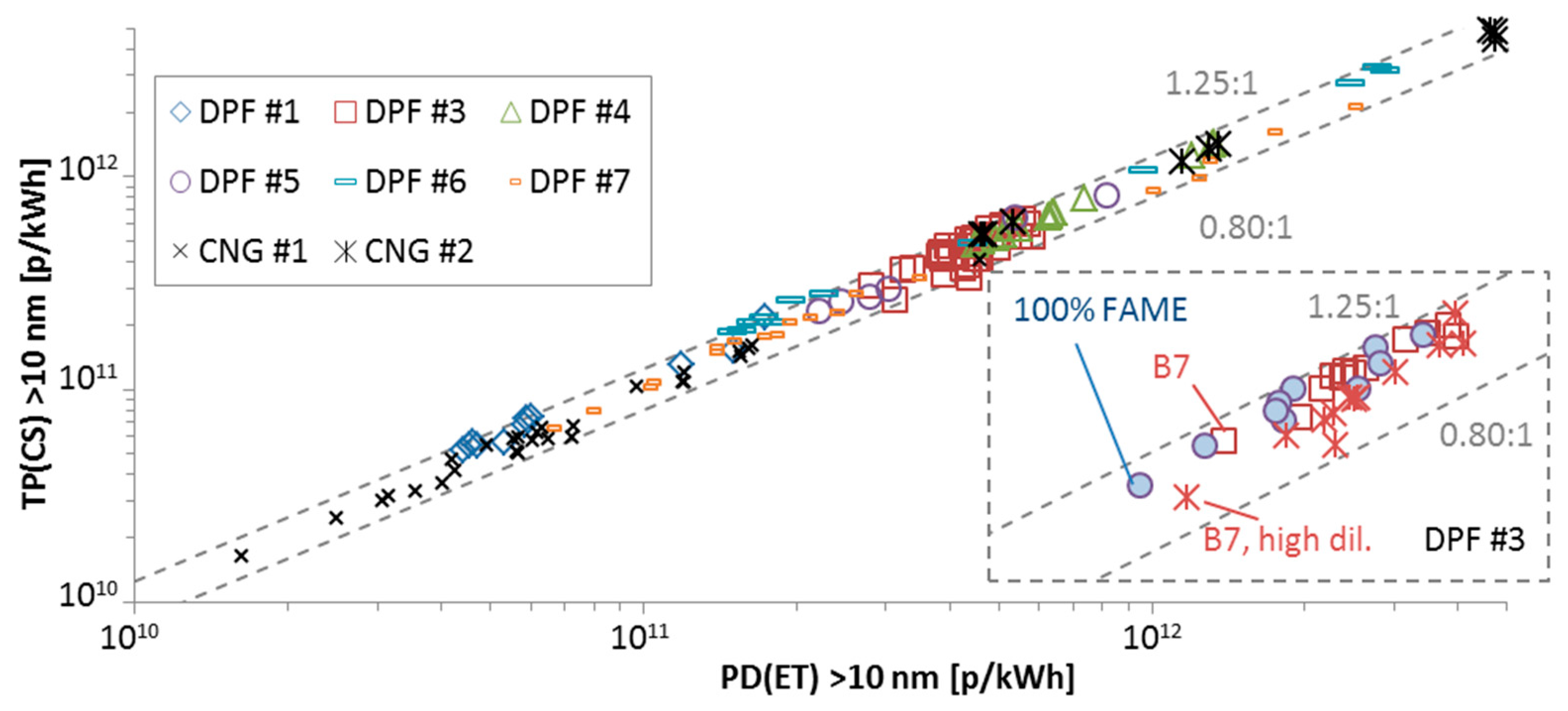
References
- Guerreiro, C.; González Ortiz, A.; de Leeuw, F.; Viana, M.; Colette, A. European Environment Agency Air quality in Europe—2018 Report; Publications Office of the European Union: Luxembourg, 2018; ISBN 978-92-9213-989-6. [Google Scholar]
- Karagulian, F.; Belis, C.A.; Dora, C.F.C.; Prüss-Ustün, A.M.; Bonjour, S.; Adair-Rohani, H.; Amann, M. Contributions to cities’ ambient particulate matter (PM): A systematic review of local source contributions at global level. Atmos. Environ. 2015, 120, 475–483. [Google Scholar] [CrossRef]
- Thunis, P.; Degraeuwe, B.; Pisoni, E.; Trombetti, M.; Peduzzi, E.; Belis, C.; Wilson, J.; Clappier, A.; Vignati, E. PM2.5 source allocation in European cities: A SHERPA modelling study. Atmos. Environ. 2018, 187, 93–106. [Google Scholar] [CrossRef]
- Fang, X.; Li, R.; Xu, Q.; Bottai, M.; Fang, F.; Cao, Y. A Two-Stage Method to Estimate the Contribution of Road Traffic to PM2.5 Concentrations in Beijing, China. Int. J. Environ. Res. Public Health 2016, 13, 124. [Google Scholar] [CrossRef] [PubMed]
- Wagner, V.; Rutherford, D. Survey of Best Practices in Emission Control of in-Use Heavy-Duty Diesel Vehicles; The International Council on Clean Transportation: Washington, DC, USA, 2013. [Google Scholar]
- Giechaskiel, B.; Schindler, W.; Jörgl, H.; Vescoli, V.; Bergmann, A.; Silvis, W. Accuracy of Particle Number Measurements from Partial Flow Dilution Systems; SAE Technical Paper Series No. 2011-24-0207; SAE International: Warrendale, PA, USA, 2011. [Google Scholar]
- Giechaskiel, B.; Schwelberger, M.; Delacroix, C.; Marchetti, M.; Feijen, M.; Prieger, K.; Andersson, S.; Karlsson, H.L.; Massimo, M. Experimental assessment of solid particle number Portable Emissions Measurement Systems (PEMS) for heavy-duty vehicles applications. J. Aerosol Sci. 2018, 123, 161–170. [Google Scholar] [CrossRef]
- Andersson, J.; Mamakos, A.; Giechaskiel, B.; Carriero, M.; Martini, G. Particle Measurement Programme (PMP) Heavy-Duty Inter-Laboratory Correlation Exercise (ILCE_HD); Publications Office: Luxembourg, 2010; ISBN 978-92-79-17200-7. [Google Scholar]
- Giechaskiel, B.; Lähde, T.; Suarez-Bertoa, R.; Clairotte, M.; Grigoratos, T.; Zardini, A.; Perujo, A.; Martini, G. Particle number measurements in the European legislation and future JRC activities. Combust. Engines 2018, 174, 3–16. [Google Scholar]
- Khan, M.Y.; Sharma, S.; Liew, C.M.; Joshi, A.; Barnes, D.; Scott, N.; Mensen, B.; Cao, T.; Li, Y.; Shimpi, S.A.; et al. Comparison of Full Flow Dilution, Partial Flow Dilution, and Raw Exhaust Particle Number Measurements. Emiss. Control. Sci. Technol. 2018, 4, 103–112. [Google Scholar] [CrossRef]
- Giechaskiel, B.; Mamakos, A.; Andersson, J.; Dilara, P.; Martini, G.; Schindler, W.; Bergmann, A. Measurement of Automotive Nonvolatile Particle Number Emissions within the European Legislative Framework: A Review. Aerosol Sci. Technol. 2012, 46, 719–749. [Google Scholar] [CrossRef]
- Burtscher, H. Physical characterization of particulate emissions from diesel engines: a review. J. Aerosol Sci. 2005, 36, 896–932. [Google Scholar] [CrossRef]
- Sharma, V.; Uy, D.; Gangopadhyay, A.; O’Neill, A.; Paxton, W.A.; Sammut, A.; Ford, M.A.; Aswath, P.B. Structure and chemistry of crankcase and exhaust soot extracted from diesel engines. Carbon 2016, 103, 327–338. [Google Scholar] [CrossRef]
- Rothe, D.; Knauer, M.; Emmerling, G.; Deyerling, D.; Niessner, R. Emissions during active regeneration of a diesel particulate filter on a heavy duty diesel engine: Stationary tests. J. Aerosol Sci. 2015, 90, 14–25. [Google Scholar] [CrossRef]
- Giechaskiel, B.; Joshi, A.; Ntziachristos, L.; Dilara, P. European Regulatory Framework and Particulate Matter Emissions of Gasoline Light-Duty Vehicles: A Review. Catalysts 2019, 9, 586. [Google Scholar] [CrossRef]
- Giechaskiel, B.; Vanhanen, J.; Väkevä, M.; Martini, G. Investigation of vehicle exhaust sub-23 nm particle emissions. Aerosol Sci. Technol. 2017, 51, 626–641. [Google Scholar] [CrossRef] [Green Version]
- Giechaskiel, B.; Manfredi, U.; Martini, G. Engine Exhaust Solid Sub-23 nm Particles: I. Literature Survey. SAE Int. J. Fuels Lubr. 2014, 7, 950–964. [Google Scholar] [CrossRef]
- Giechaskiel, B. Solid Particle Number Emission Factors of Euro VI Heavy-Duty Vehicles on the Road and in the Laboratory. Int. J. Environ. Res. Public Health 2018, 15, 304. [Google Scholar] [CrossRef] [PubMed]
- Giechaskiel, B.; Drossinos, Y. Theoretical Investigation of Volatile Removal Efficiency of Particle Number Measurement Systems. SAE Int. J. Engines 2010, 3, 1140–1151. [Google Scholar] [CrossRef]
- Giechaskiel, B.; Martini, G. Engine Exhaust Solid Sub-23 nm Particles: II. Feasibility Study for Particle Number Measurement Systems. SAE Int. J. Fuels Lubr. 2014, 7, 935–949. [Google Scholar] [CrossRef]
- Giechaskiel, B.; Carriero, M.; Martini, G.; Bergmann, A.; Pongratz, H.; Joergl, H. Comparison of Particle Number Measurements from the Full Dilution Tunnel, the Tailpipe and Two Partial Flow Systems; SAE Technical Paper Series No. 2010-01-1299; SAE International: Warrendale, PA, USA, 2010. [Google Scholar]
- Giechaskiel, B.; Wang, X.; Horn, H.-G.; Spielvogel, J.; Gerhart, C.; Southgate, J.; Jing, L.; Kasper, M.; Drossinos, Y.; Krasenbrink, A. Calibration of Condensation Particle Counters for Legislated Vehicle Number Emission Measurements. Aerosol Sci. Technol. 2009, 43, 1164–1173. [Google Scholar] [CrossRef]
- Wang, X.; Caldow, R.; Sem, G.J.; Hama, N.; Sakurai, H. Evaluation of a condensation particle counter for vehicle emission measurement: Experimental procedure and effects of calibration aerosol material. J. Aerosol Sci. 2010, 41, 306–318. [Google Scholar] [CrossRef]
- Takegawa, N.; Sakurai, H. Laboratory Evaluation of a TSI Condensation Particle Counter (Model 3771) Under Airborne Measurement Conditions. Aerosol Sci. Technol. 2011, 45, 272–283. [Google Scholar] [CrossRef]
- Amanatidis, S.; Ntziachristos, L.; Giechaskiel, B.; Katsaounis, D.; Samaras, Z.; Bergmann, A. Evaluation of an oxidation catalyst (“catalytic stripper”) in eliminating volatile material from combustion aerosol. J. Aerosol Sci. 2013, 57, 144–155. [Google Scholar] [CrossRef]
- Wei, Q.; Oestergaard, K.; Porter, S.; Ichiro, A.; Adachi, M.; Montajir, R.M. Real-Time Measuring System for Engine Exhaust Solid Particle Number Emission—Design and Performance; SAE Technical Paper Series No. 2006-01-0864; SAE International: Warrendale, PA, USA, 2006. [Google Scholar]
- Giechaskiel, B.; Lähde, T.; Drossinos, Y. Regulating particle number measurements from the tailpipe of light-duty vehicles: The next step? Environ. Res. 2019, 172, 1–9. [Google Scholar] [CrossRef] [PubMed]
- Mohanta, L.; Iyer, S.; Mishra, P.; Klinikowski, D. Uncertainties in Measurements of Emissions in Chassis Dynamometer Tests; SAE Technical Paper Series No. 2014-01-1584; SAE International: Warrendale, PA, USA, 2014. [Google Scholar]
- Giechaskiel, B.; Chirico, R.; Decarlo, P.; Clairotte, M.; Adam, T.; Martini, G.; Heringa, M.; Richter, R.; Prevot, A.; Baltensperger, U.; et al. Evaluation of the particle measurement programme (PMP) protocol to remove the vehicles’ exhaust aerosol volatile phase. Sci. Total Environ. 2010, 408, 5106–5116. [Google Scholar] [CrossRef] [PubMed]
- Giechaskiel, B.; Arndt, M.; Schindler, W.; Bergmann, A.; Silvis, W.; Drossinos, Y. Sampling of Non-Volatile Vehicle Exhaust Particles: A Simplified Guide. SAE Int. J. Engines 2012, 5, 379–399. [Google Scholar] [CrossRef]
- Johnson, B.T.; Hargrave, G.K.; Reid, B.; Page, V.J. Crankcase Sampling of PM from a Fired and Motored Compression Ignition Engine. SAE Int. J. Engines 2011, 4, 2498–2509. [Google Scholar] [CrossRef] [Green Version]
- Uy, D.; Storey, J.; Sluder, C.S.; Barone, T.; Lewis, S.; Jagner, M. Effects of Oil Formulation, Oil Separator, and Engine Speed and Load on the Particle Size, Chemistry, and Morphology of Diesel Crankcase Aerosols. SAE Int. J. Fuels Lubr. 2016, 9, 224–238. [Google Scholar] [CrossRef]
- Bai, J.; Qiao, X. Crankcase gaseous and particle emissions in common rail diesel engine. Int. J. Engine Res. 2016, 17, 179–192. [Google Scholar] [CrossRef]
- Ruehl, C.; Smith, J.D.; Ma, Y.; Shields, J.E.; Burnitzki, M.; Sobieralski, W.; Ianni, R.; Chernich, D.J.; Chang, M.-C.O.; Collins, J.F.; et al. Emissions During and Real-world Frequency of Heavy-duty Diesel Particulate Filter Regeneration. Environ. Sci. Technol. 2018, 52, 5868–5874. [Google Scholar] [CrossRef]
- Giechaskiel, B.; Gioria, R.; Carriero, M.; Lähde, T.; Forloni, F.; Perujo, A.; Martini, G.; Bissi, L.M.; Terenghi, R. Emission Factors of a Euro VI Heavy-duty Diesel Refuse Collection Vehicle. Sustainability 2019, 11, 1067. [Google Scholar] [CrossRef]
- Quiros, D.C.; Yoon, S.; Dwyer, H.A.; Collins, J.F.; Zhu, Y.; Huai, T. Measuring particulate matter emissions during parked active diesel particulate filter regeneration of heavy-duty diesel trucks. J. Aerosol Sci. 2014, 73, 48–62. [Google Scholar] [CrossRef]
- Yoon, S.; Quiros, D.C.; Dwyer, H.A.; Collins, J.F.; Burnitzki, M.; Chernich, D.; Herner, J.D. Characteristics of particle number and mass emissions during heavy-duty diesel truck parked active DPF regeneration in an ambient air dilution tunnel. Atmos. Environ. 2015, 122, 58–64. [Google Scholar] [CrossRef]
- Smith, J.D.; Ruehl, C.; Burnitzki, M.; Sobieralski, W.; Ianni, R.; Quiros, D.; Hu, S.; Chernich, D.; Collins, J.; Huai, T.; et al. Real-time particulate emissions rates from active and passive heavy-duty diesel particulate filter regeneration. Sci. Total Environ. 2019, 680, 132–139. [Google Scholar] [CrossRef] [PubMed]
- Yamada, H.; Inomata, S.; Tanimoto, H. Mechanisms of Increased Particle and VOC Emissions during DPF Active Regeneration and Practical Emissions Considering Regeneration. Environ. Sci. Technol. 2017, 51, 2914–2923. [Google Scholar] [CrossRef] [PubMed]
- Giechaskiel, B. Differences between tailpipe and dilution tunnel sub-23 nm nonvolatile (solid) particle number measurements. Aerosol Sci. Technol. 2019, 53, 1012–1022. [Google Scholar] [CrossRef] [Green Version]
- Giechaskiel, B.; Bergmann, A. Validation of 14 used, re-calibrated and new TSI 3790 condensation particle counters according to the UN-ECE Regulation 83. J. Aerosol Sci. 2011, 42, 195–203. [Google Scholar] [CrossRef]
- Gao, Z.; Liu, S.X.; Mai, H.Z.; Hao, J.H. Research on the Full-Flow and Partial-Flow Dilution Sampling Systems for Exhaust Gas of Engine. Adv. Mater. Res. 2013, 718, 1394–1399. [Google Scholar] [CrossRef]
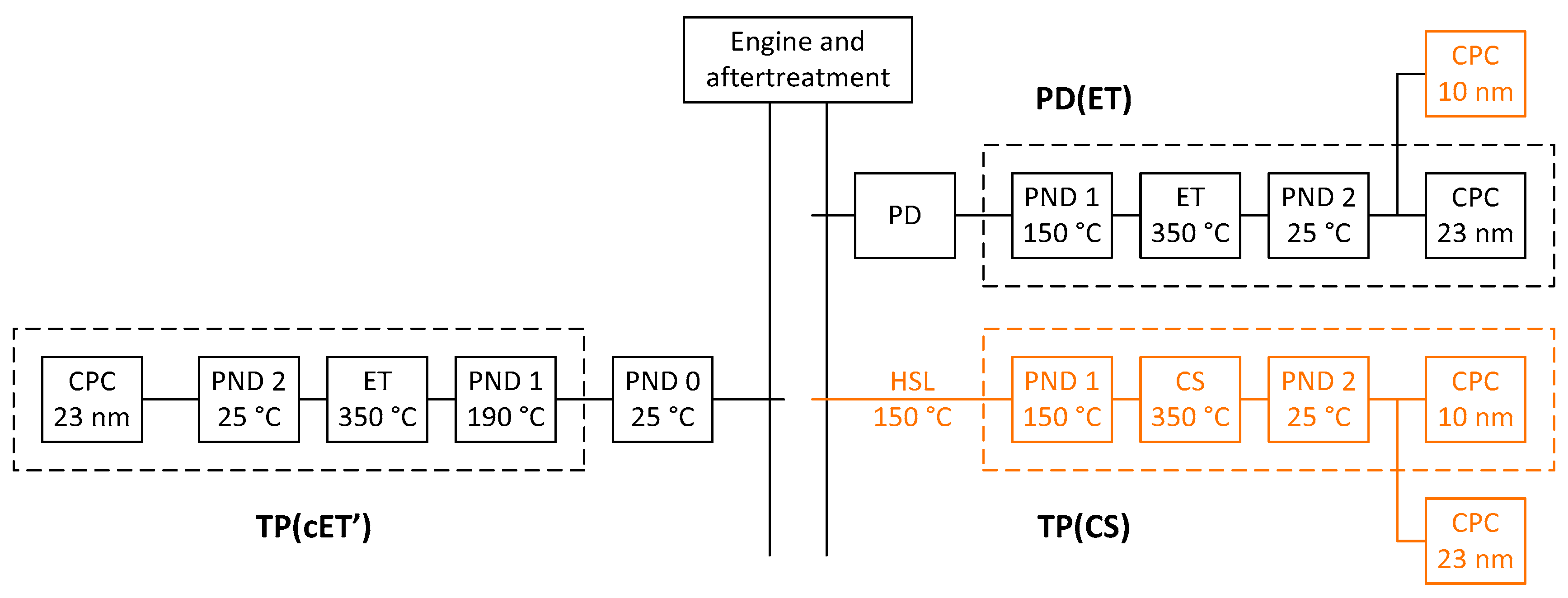




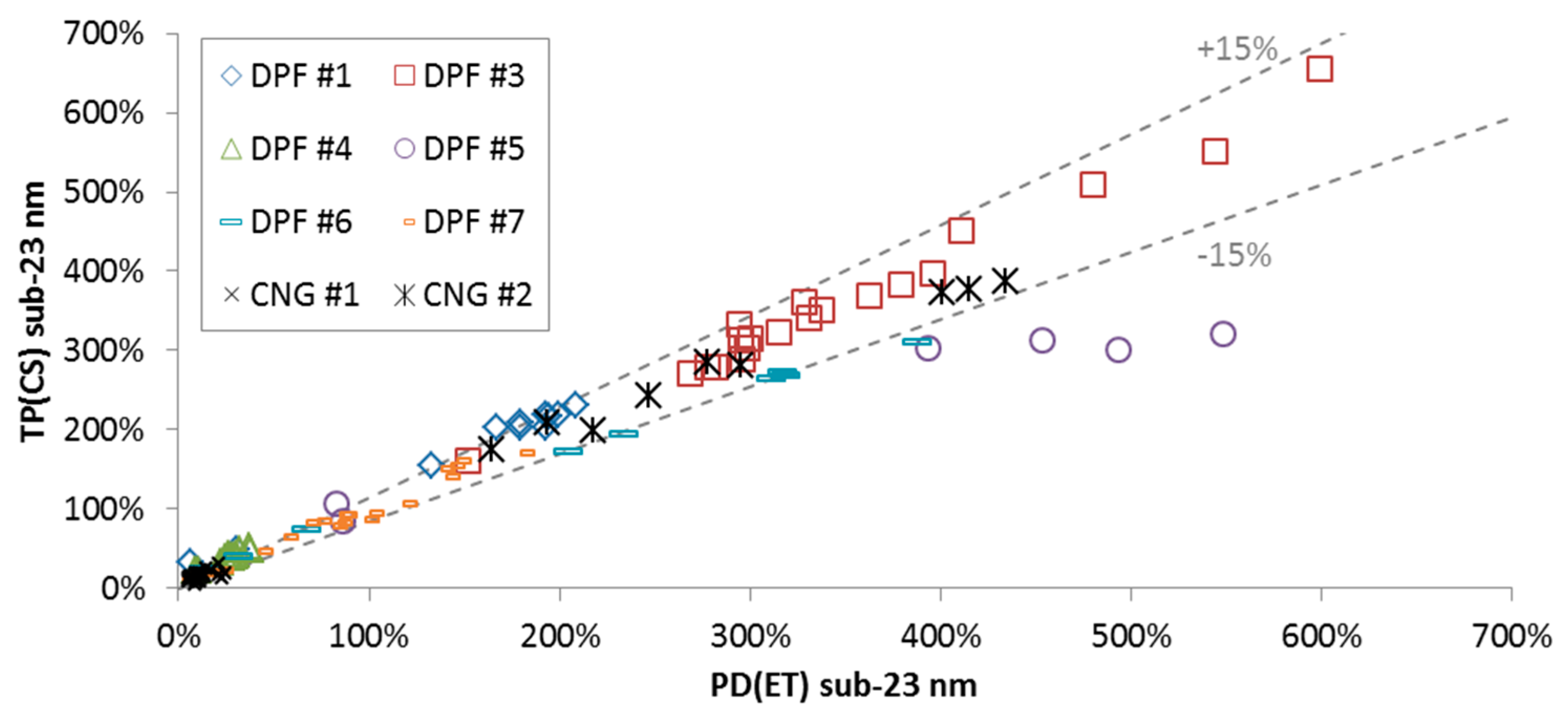
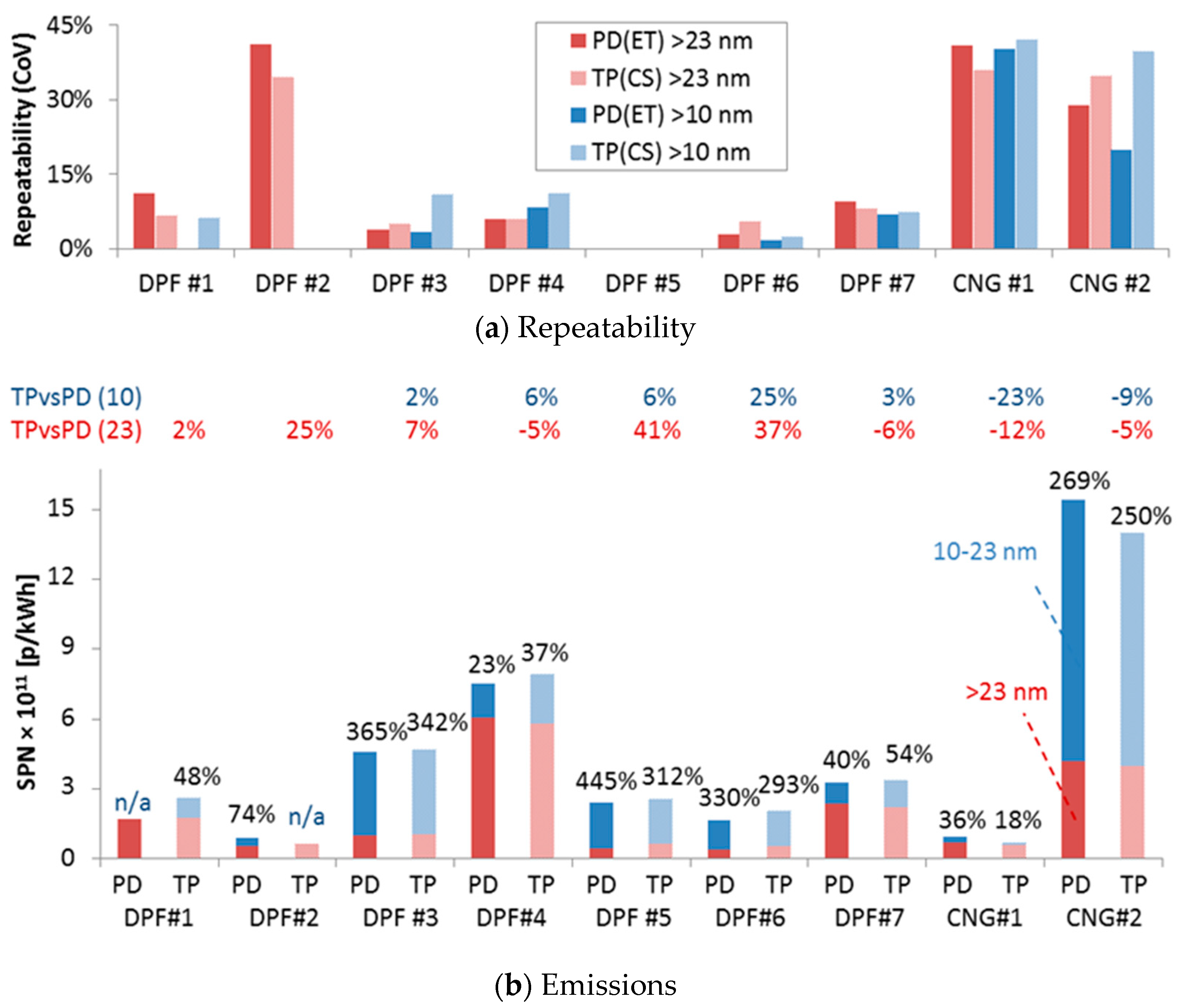
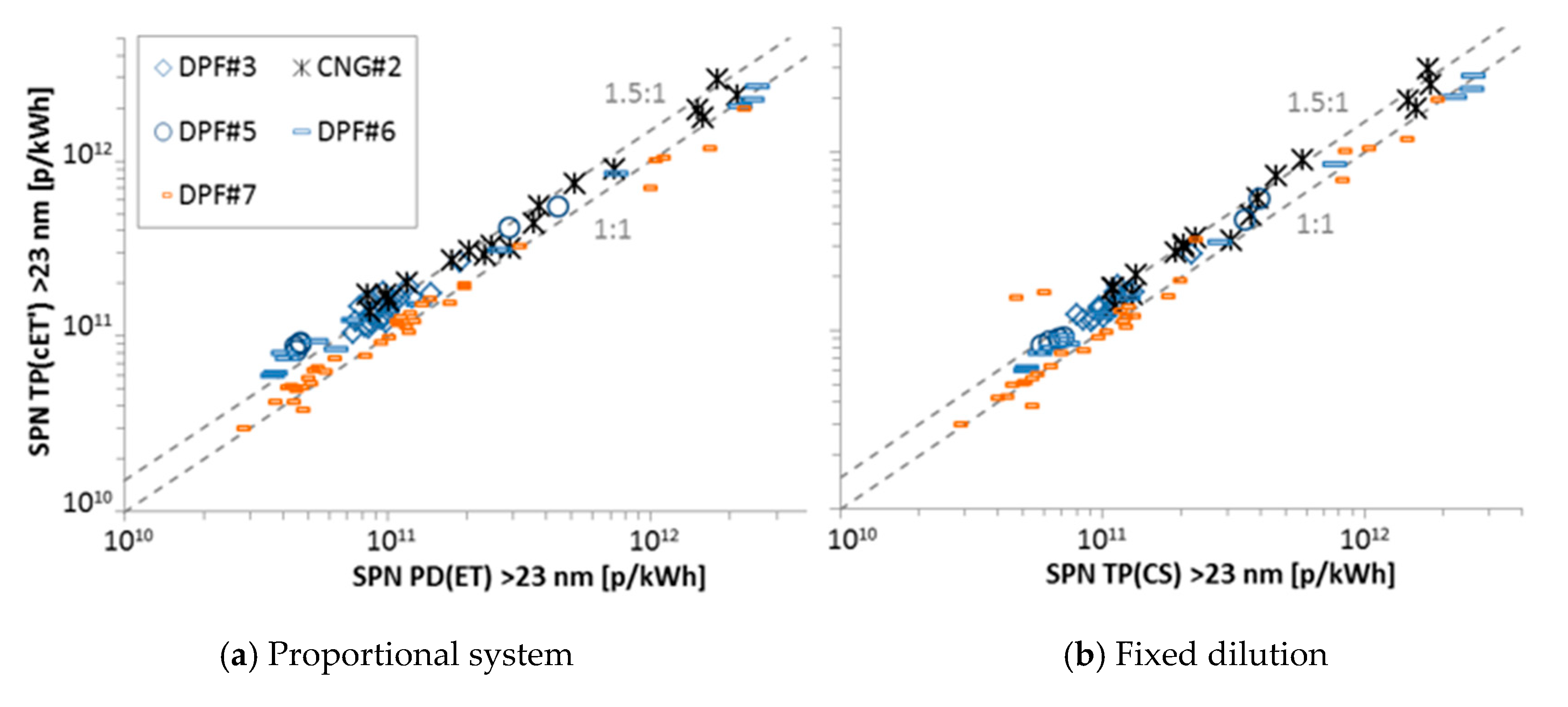
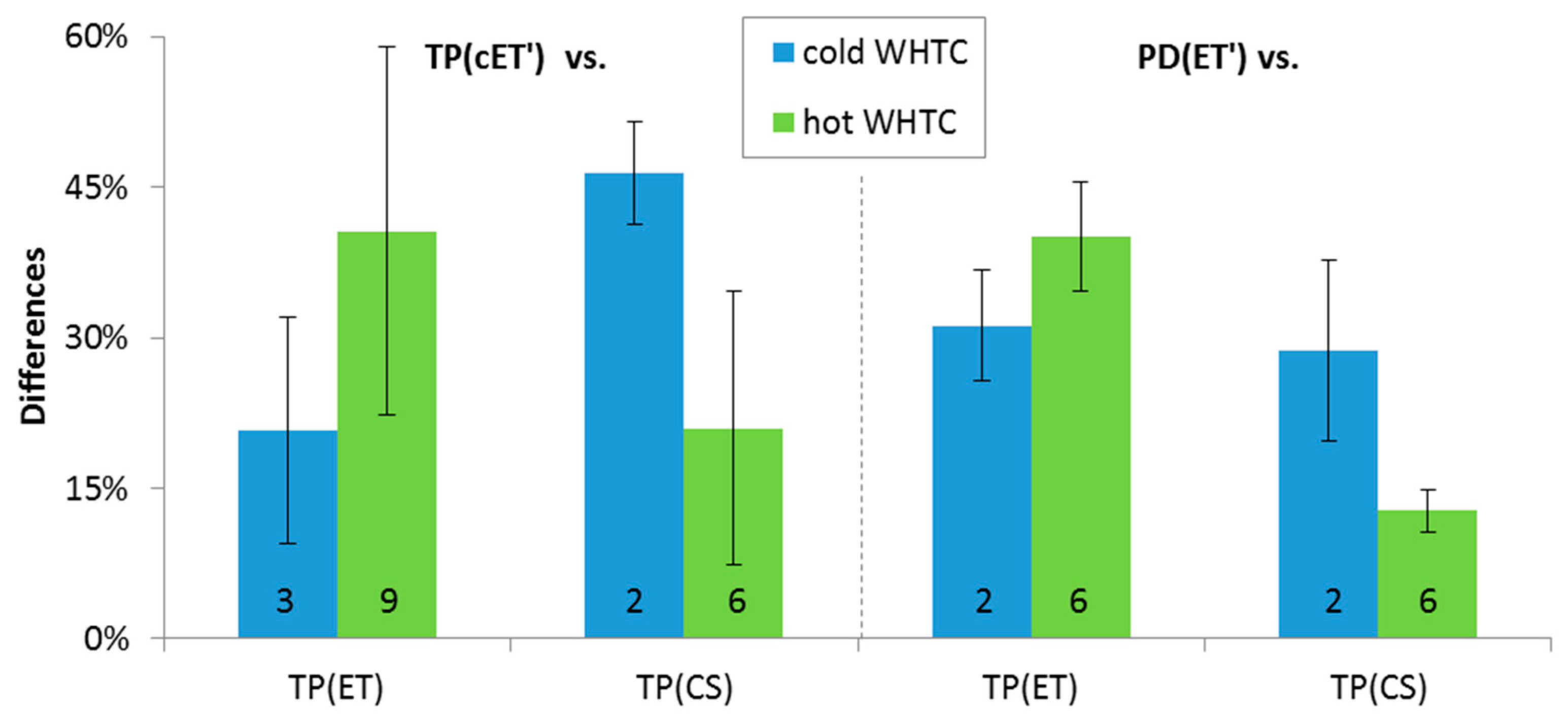
| Investigated Conditions | DPF #1 | DPF #2 | DPF #3 | DPF #4 | DPF #5 | DPF #6 | DPF #7 | CNG #1 | CNG #2 |
|---|---|---|---|---|---|---|---|---|---|
| Extra cycles | Y | - | Y | Y | Y | Y | Y | Y | - |
| Crankcase | Y | - | - | Y | - | - | Y | - | - |
| Regeneration | Y | - | Y | Y | Y | - | - | - | - |
| Biofuel | - | - | Y | - | - | - | - | - | - |
| Sampling line | - | Y | Y | - | - | - | - | - | Y |
| Extra tailpipe | - | - | Y | - | Y | Y | Y | - | Y |
| Parallel check | - | Y | Y | - | Y | Y | - | - | Y |
© 2019 by the authors. Licensee MDPI, Basel, Switzerland. This article is an open access article distributed under the terms and conditions of the Creative Commons Attribution (CC BY) license (http://creativecommons.org/licenses/by/4.0/).
Share and Cite
Giechaskiel, B.; Lähde, T.; Schwelberger, M.; Kleinbach, T.; Roske, H.; Teti, E.; van den Bos, T.; Neils, P.; Delacroix, C.; Jakobsson, T.; et al. Particle Number Measurements Directly from the Tailpipe for Type Approval of Heavy-Duty Engines. Appl. Sci. 2019, 9, 4418. https://doi.org/10.3390/app9204418
Giechaskiel B, Lähde T, Schwelberger M, Kleinbach T, Roske H, Teti E, van den Bos T, Neils P, Delacroix C, Jakobsson T, et al. Particle Number Measurements Directly from the Tailpipe for Type Approval of Heavy-Duty Engines. Applied Sciences. 2019; 9(20):4418. https://doi.org/10.3390/app9204418
Chicago/Turabian StyleGiechaskiel, Barouch, Tero Lähde, Matthias Schwelberger, Timo Kleinbach, Helge Roske, Enrico Teti, Tim van den Bos, Patrick Neils, Christophe Delacroix, Tobias Jakobsson, and et al. 2019. "Particle Number Measurements Directly from the Tailpipe for Type Approval of Heavy-Duty Engines" Applied Sciences 9, no. 20: 4418. https://doi.org/10.3390/app9204418





